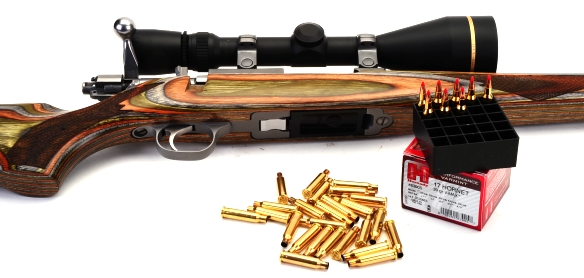
The Ruger 77/17 17 Hornet made it to the range with lots of factory ammo and handloads… after a good bore scrubbing and overall clean up. I don’t think 17s copper foul any more than any other similar performance calibers, however, the bore is very small and keeping rifling sharp and clean goes directly to accuracy.
But first… Some additional 17 Hornet information.
I mentioned in Part 1 that the Hornady 17 Hornet is not the 17 Ackley Improved Hornet and that there were actually several 17/22 Hornets that predated Ackley’s work*. The drawing below indicates some of the differences between the new Hornady 17 Hornet and the 17 Ackley Hornet.
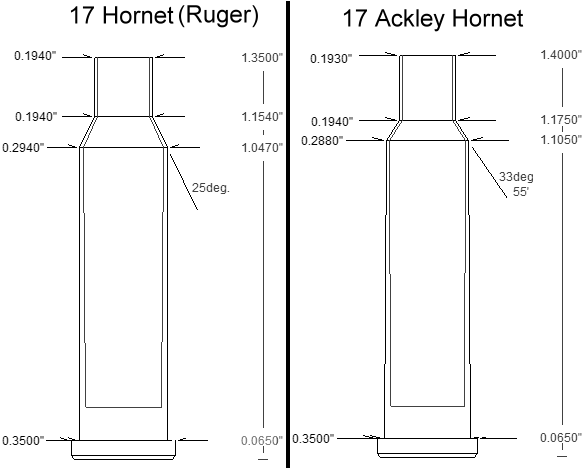
The 17 Hornet has a nominal capacity of 14.7 grains of water, the Ackley Improved Hornet has a nominal capacity of 15.1. The 17 Hornet new brass wet checked at 14.6 grains, then wet checked at 14.3 after being fired in the Ruger 77/17’s chamber, then 13.9 grains after full length sizing in Hornady dies. As case full loading is not typical, based on the selection of suitable powder, the difference in capacity is purely academic. The Pmax pressure for the 17 Hornet is a moderate 50,000 psi.
It’s kindergarten art class all over again…
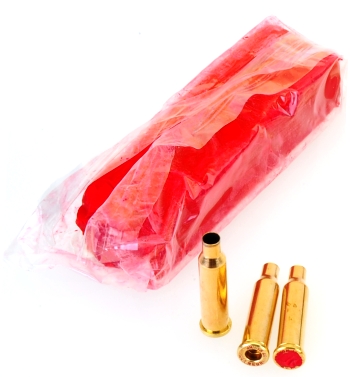
Reloading a relatively new cartridge of this type, in the absence of a lot of industry data, requires some caution, particularly when the cartridge is small. A one grain error when reloading a 378 Weatherby is a seven tenths of one percent error and hardly noticeable. A one grain error when reloading a cartridge like the 17 Hornet is a ten percent error that can move a handload from safe to “Oops! Sorry.”
| Case State |
Capacity |
Relative Pressure PSI |
| Unfired | 14.6 | 49,879 |
| Fired | 14.3 | 52,082 |
| Sized | 13.9 | 55.388 |
The table above represents wet measurement of 17 Hornet cases in three different states and the resulting pressure change where the powder charge remains constant.
To accommodate small case measurement wet measurement – Distilled water has fewer air bubbles and won’t skew readings. A long nose dropper can inject water below the neck and allow air bubbles to escape while the case is being filled. A needleless irrigation syringe will do the same, both are drugstore items. Modeling clay can be used to plug primer pockets in unprimed brass so they won’t leak.
Bullet, bullet, who’s got…
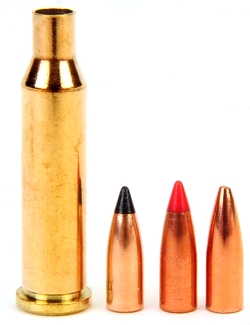
Selecting a 17 caliber bullet isn’t tough. They come in 20, 25 and 30 grain weights from roughly four primary manufacturers: Berger, Hornady, Nosler and Remington. Tipped or hollow point, they are all made to expand aggressively. Pictured right, left to right, Nosler 20 grain Varmageddon, Hornady 20 grain V-Max and Hornady 25 grain HP.
As a moderate range varmint cartridge, ballistic performance is emphasized inside of 300 yards. All of the available bullets have a low sectional density and ballistic coefficient, the equivalent of 0.308″ bullet that weighs 95 grains. As a rule of thumb, 17 caliber cartridges usually start off screaming so they can get the job done inside 300 yards.
Moving up from a 17 caliber 20 grain bullet to 30 grains is a big step. This is a 50% increase in bullet weight, or the equivalent of bumping a 0.308″ bullet up from 180 grains to 270 grains and, just like the 0.308″ bullet, the effect will be a significant velocity drop off.
Of the twelve bullet types in production from all manufacturers, the Ruger 77/17’s 9″ twist is in keeping with all product recommendations. Bullet lengths range from 0.565″ to 0.637″. All of the handloads represented where based on once previously fired Hornady brass.
Warning: Bullet selections are specific, and loads are not valid with substitutions of different bullets of the same weight. Variations in bullet material and length will alter net case capacity, pressure and velocity results. Primer selection is specific and primer types are not interchangeable. These data represents maximum loads in our firearms and test equipment and may easily be excessive in other applications. All loads should be reduced by 3%, and developed following safe handloading practices as represented in established reloading manuals produced by component manufacturers. Presentation of these loads does not constitute a solicitation for their use, nor a recommendation.
|
|||||||||||||||||||||||||||||||||||||||||||||||||||||||||||||||||||||||||
|
|
|||||||||||||||||||||||||||||||||||||||||||||||||||||||||||||||||||||||||
What does that look like on paper?
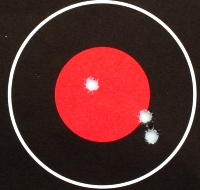
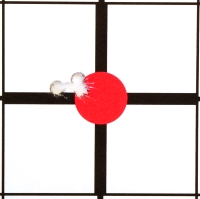
Left, a factory Superformance three shot 1.00″ group. Right, a miniscule 0.25″ group made with a 20 grain Hornady V-Max and 10.2 grains of Lil’ Gun powder.
The Superformance group was first of the day and shot cold. The 20 Grain V-Max was second group shot during the session.
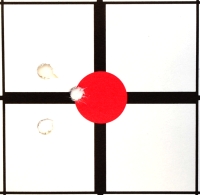
Left, the Nosler 20 grain, with 10.5 grains of IMR 4227 measured 0.65″, which was about the same as the Lil’ Gun group shot immediately after.
Right, the Hornady 25 grain HP Lil’ Gun load. A little slower than the speedy 20 grain bullets, but a 0.50″ three shot group.
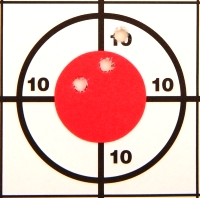 No, I did not extend the bullet out to greet the lands, nor did I do anything else was exciting. Just basic brass prep, clean up and squaring and careful assembly. I don’t believe I had the best powder on hand for the application. Accurate 1680 would have been a good one and Alliant 2400 could have been good. Lil’ Gun proved to be good, I avoided W296 and H110 because I like to load those where the case is full and that could not be done with the 17 Hornet. Next time we’ll try the rest.
No, I did not extend the bullet out to greet the lands, nor did I do anything else was exciting. Just basic brass prep, clean up and squaring and careful assembly. I don’t believe I had the best powder on hand for the application. Accurate 1680 would have been a good one and Alliant 2400 could have been good. Lil’ Gun proved to be good, I avoided W296 and H110 because I like to load those where the case is full and that could not be done with the 17 Hornet. Next time we’ll try the rest.
From the perspective of handloading, the 17 Hornet and the Ruger 77/17 is a nice combination. This is not one of those rounds where factory velocity is out of reach of the average handloader or where special powder not available to the consumer is required. Factory ammo runs about $18/box of 25. New bare brass is approximately 56 cents with ten reloads reasonable… 6 cents worth of brass per reload. Hornady bulk varmint bullets cost 9 cents each, with V-Max 20 grain at 18 cents and Nosler 20 grain at 13 cents. Beats the heck out of the buck and a half per round 45-70.
On the way out the door…
This is a rifle lots of people should take to the range for proficiency training and for varmint and small game hunting. It is quiet, has no recoil and is inexpensive to shoot. Best of all, it has all of the accuracy necessary to develop solid shooting skills.

It is a big plus that handloading is not necessary to achieve accuracy and factory ammo is inexpensive, about the same as the 17 HMR rimfire. The Ruger is well made, not a chunk of thin wall steel tubing and a blow molded stock. It is a rifle that offers pride of ownership with enough stock and hardware precision to make it into an enjoyable recreational shooter.
Stop by the Ruger site for more information on the Ruger 77/17 and other rotary magazine models.
*Handbook for Shooters and Reloaders – P.O. Ackley
Ruger’s 77/17® 17 Hornet Part 1
Ruger’s 77/17® 17 Hornet Part 2

Email Notification